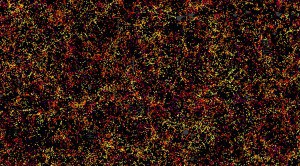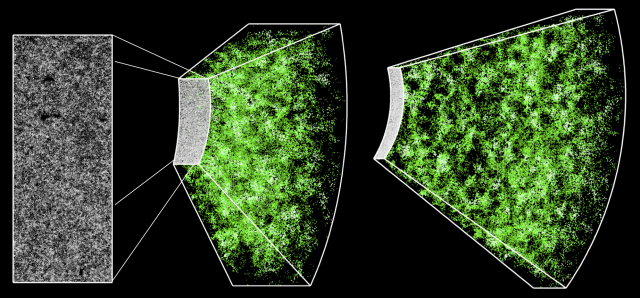
Scientists from the Sloan Digital Sky Survey collaboration (SDSS) have produced the largest three-dimensional map of the sky. The final image represents only about 3% of the volume mapped, with each pixel correlating to an entire galaxy, and each color representing an individual galaxy’s distance from Earth; yellow objects are the closest, and purple are furthest away. To locate 1.2 million galaxies, the scientists prepared the map for over five years through the Baryon Oscillation Spectroscope Survey (BOSS) program, which studies how dark energy – the repulsive force believed to make the universe expand at accelerating rates – drives the expansion of the universe. Overall, the map contains a volume of 650 billion cubic light years.
The rectangle in the image below shows 1000 square degrees in the sky that contain galaxies, displaying that about 10% of the surveyed area include galaxies. The spectroscopic measurements of each galaxy (the dots) are what give the map its 3D status and provide the viewer a glance back at 7 billion years into the past. The scientists compiled the map with the help of Apache Point Observatory’s 2.5m wide-angle optical telescope in New Mexico, observing the sky to measure redshift. Occurring when astronomical objects move away and shift light to the red end of the spectrum, redshift is essential to tracking the universe’s expansion. The final version of the map allowed scientists to determine the amount of dark energy and matter that comprise the universe.

“Dark energy is 69% of the ‘energy density’ in the universe today,” said David Schlegel, an astrophysicist who is a principal investigator at BOSS. “What that means is that it’s dominating how the universe is evolving today, and we think will eventually tear it apart such that we can no longer see any other galaxies.”
The map reveals that galaxies form into trailing superclusters shot through a void that began existing as matter spread haphazardly after the Big Bang. A SDSS statement reads, “Galaxies are preferentially separated by a characteristic distance that astronomers call the acoustic scale. The size of the acoustic scale at 13.48 billion years ago has been exquisitely determined from observations of the cosmic microwave background from the light emitted when the pressure waves become frozen.”
Scientists can compare the current state of the universe to an older version by looking at the size of baryonic acoustic oscillations (BAO – fluctuations or pressure waves in the density of visible matter) seen in the 3D figures. Doing so led to finding an exact figure of the universe’s expansion rate. “The present-day universe is expanding by 1% in each direction every 145 million years. If there were no dark energy, it would be expanding more slowly,” said Schlegel. The 3D map is also able to measure how much the galaxies and stars cluster together, which enables the research team to test general relativity at a cosmological level.
“If dark energy has been driving the expansion of the universe over that time, our map tells us that it is evolving very slowly, if at all,” said collaborator Dr. Florian Beutler. “The change is at most 20 percent over the past seven billion years.”
Source: ExtremeTech, Gizmag
Advertisement
Learn more about Electronic Products Magazine





